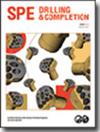Identifying Formation Creep: Ultrasonic Bond Logging Field Examples
IF 1.2
4区 工程技术
Q3 ENGINEERING, PETROLEUM
引用次数: 3
Abstract
As part of plug and abandonment (P&A) operations, several acceptance criteria need to be considered by operators to qualify barrier elements. In casing annuli, highly bonded material is occasionally found far above the theoretical top of cement. This paper aims to describe how the highly bonded material can be identified using a combination of ultrasonic logging data, validated with measurements in laboratory experiments using reference cells and how this, in combination with data from the well construction records, can contribute to lowering the costly toll of P&A operations. Ultrasonic and sonic log data were acquired in several wells to assess the bond quality behind multiple casing sizes in an abandonment campaign. Data obtained from pulse-echo and flexural sensors were interactively analyzed with a crossplotting technique to distinguish gas, liquid, barite, cement, and formation in the annular space. Within the methodology used, historical data on each well were considered as an integral part of the analysis. During the original well construction, either water-based mud (WBM) or synthetic oil-based mud (OBM) was used for drilling and cementing operations, and some formation intervals consistently showed high bonding signatures under specific conditions, giving clear evidence of formation creep. Log data from multiple wells confirm that formation behavior is influenced by the type of mud used during well construction. The log data provided information of annulus material with a detailed map of the axial and azimuthal variations of the annulus contents. In some cases, log response showed a clear indication of formation creep, evidenced by a high bond quality around the production casing where cement cannot be present. Based on observations from multiple fields in the Norwegian continental shelf, a crossplot workflow has been designed to distinguish formation from cement as the potential barrier element. NORSOK Standard D-010 (2013) has initial verification acceptance criteria both for annulus cement and creeping formation as a well barrier element, both involving bond logs; however, in the case of creeping formation, it is more stringent stating that “two independent logging measurements/tools shall be applied.” This paper aims to demonstrate how this can be done with confidence using ultrasonic and sonic log data, validated against reference barrier cells (Govil et al. 2020). Logging responses like those gathered during full-scale experiments of reference barrier cells with known defects were observed in multiple wells in the field. Understanding the phenomenon of formation creep and its associated casing bond signature could have a massive impact on P&A operations. With a successful qualification of formation as an annulus barrier, significant cost and time savings can be achieved.识别地层蠕变:超声波粘结测井现场实例
作为封堵和废弃(P&A)操作的一部分,运营商需要考虑几个验收标准,以确定屏障元件的合格性。在套管环空中,有时会发现高度粘结的材料远远高于水泥的理论顶部。本文旨在描述如何使用超声波测井数据的组合来识别高度粘结的材料,并通过使用参考细胞的实验室实验中的测量进行验证,以及这与油井施工记录中的数据的组合如何有助于降低昂贵的P&a操作费用。在几口井中采集了超声波和声波测井数据,以评估废弃作业中多种套管尺寸背后的粘结质量。利用交会图技术对从脉冲回波和弯曲传感器获得的数据进行交互分析,以区分环形空间中的气体、液体、重晶石、水泥和地层。在所使用的方法中,每口井的历史数据都被视为分析的组成部分。在最初的油井施工过程中,钻井和固井作业使用了水基泥浆(WBM)或合成油基泥浆(OBM),一些地层层段在特定条件下始终显示出高粘结特征,为地层蠕变提供了明确的证据。来自多口井的测井数据证实,地层行为受到井施工期间使用的泥浆类型的影响。测井数据提供了环空物质的信息,以及环空内容物的轴向和方位角变化的详细地图。在某些情况下,测井响应显示出地层蠕变的明显迹象,这可以通过无法存在水泥的生产套管周围的高粘结质量来证明。根据挪威大陆架多个油田的观测结果,设计了一个交会图工作流程,以区分地层和水泥作为潜在屏障元素。NORSOK标准D-010(2013)对环空水泥和作为油井屏障元件的蠕变地层都有初步验证验收标准,两者都涉及粘结测井;然而,在蠕变地层的情况下,更严格的规定是“应使用两种独立的测井测量/工具。在现场的多个井中观察到了类似于在具有已知缺陷的参考屏障细胞的全尺寸实验中收集的测井响应。了解地层蠕变现象及其相关的套管粘结特征可能会对P&a操作产生巨大影响。成功地将地层鉴定为环空屏障,可以实现显著的成本和时间节约。
本文章由计算机程序翻译,如有差异,请以英文原文为准。
求助全文
约1分钟内获得全文
求助全文
来源期刊

SPE Drilling & Completion
工程技术-工程:石油
CiteScore
4.20
自引率
7.10%
发文量
29
审稿时长
6-12 weeks
期刊介绍:
Covers horizontal and directional drilling, drilling fluids, bit technology, sand control, perforating, cementing, well control, completions and drilling operations.
 求助内容:
求助内容: 应助结果提醒方式:
应助结果提醒方式:


